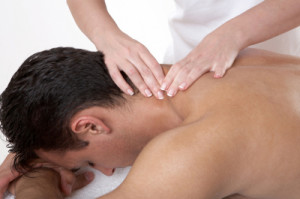Swedish massage is the basis of all massage techniques and is general massage that would suit someone who has general aches and pains and not looking to treat specific problem areas. Although an experienced therapist adapts pressure levels to suit the underlying structures, I would say in my practice this is a medium pressure type of treatment I categorize as “General Massage”. If you are looking for a more deeper treatment to target areas of tension I would suggest asking for a deep tissue treatment. This will be discussed in your consultation.
Massage involves working the soft tissue of the body, to ease day-to-day stresses and muscular tension, and promote relaxation. It helps to increase delivery of blood and oxygen to the treated areas and can also be used in support of other therapies to assist in the rehabilitation of muscular injuries.
There is a growing body of evidence to suggest that massage can be effective in helping to treat certain chronic conditions, such as fibromyalgia and low back pain among many more. In guidelines produced in 2009 by the National Institute for Health and Clinical Excellence (NICE), manual therapies – including massage – are recommended for the early management of persistent, non-specific low back pain.
There are different styles & techniques of massage that a therapist should be qualified in order to practice.If you are visiting Buddu with a specific problem(s) I will combine techniques in order to give you the best possible treatment based on the consultation & assessment.
Benefits
Relaxes and induces sleep
Increases blood and lymphatic circulation
Improves function and appearance of skin
Helps to break down fatty tissue and cellulite
Relaxes tight muscles and improves the function and tone
Maintains/ increases mobility of bones, as well as increasing circulation and nourishment of bones
Improves posture
Relieves stiff joints
Improves digestion, constipation and flatulence
Encourages deeper and more relaxed breathing
Helps to reduce stress
Provides a sense of well being
HISTORY
Swedish body massage emerged in Europe in the early 1800s. A Swedish physiologist, Per Henrik Ling (1776-1839), travelled to China and returned with a detailed insight into their massage techniques. From this he developed his own system of massage, combining his knowledge of physiology, gymnastics, Chinese, Greek, Roman and Egyptian massage techniques. Many of the techniques he devised are used today, including effleurage, petrissage, vibrations, rotation, friction, rolling and slapping. This is modern Swedish Body Massage.
In 1813 the first college to offer Swedish body massage was established in Stockholm and it later spread across Europe.
In 1894 the Society of Trained Masseuses was formed and it worked hard to raise standards and promote massage as a professional occupation. In 1899 Sir William Bennett opened a massage department in St. George’s Hospital, London, establishing massage as an accepted form of treatment in the medical profession. Massage was used to treat people during both world wars and since the 1960s and the rise of the human growth movement, which believed that people didn’t have to be ‘sick’ to benefit from massage, there has been a continuous demand.
Prices for Swedish/General – if you are unsure what you would like then choose the amount of time you would like to book and I will assist you with your decision based on the information you provide.
Areas of treatment can include – scalp, face, ears, neck, chest, back, shoulders, arms, hands, abdomen, legs & feet).
Scalp and Face are optional but I do encourage clients to try because of the are at the top of the neck and scalp accumulates lots of tension.
Important Information about your treatment
If you have any sensitivities, allergies especially to nuts or you are pregnant then other base oils can be used.
All treatments can be adapted to suit what is right for you. Treatment descriptions are only guidelines to give you an idea what treatment involves. Each treatment is unique and although has a basic structure does change depending on the day how you are feeling and how the soft tissue structures are responding.
A full consultation is carried out on your first visit to ensure there are no contra-indications to prevent the treatment from taking place. If I am in a situation where I feel it is not within my scope of practice to treat you I will refer you on to the appropriate persons. If a doctors permission is required treatment will not proceed. All information is confidential so it is crucial that you do not withhold anything that may be relevant. If you are unsure please ask. When the consultation is complete you will be given time to prepare yourself for your treatment.
Read More →
Please see full terms and conditions here
Covid-19 Policy and Information about your treatment here
It is important to choose a qualified massage therapist who has undertaken the necessary training to understand the theory and practice of this particular therapy.
Janine Lingard is a massage therapist who is an FHT member, you can be confident that she is professionally trained, qualified and insured. Janine will also be listed on our Complementary Healthcare Therapist Register, as massage is considered a form of complementary healthcare. See link below.
FHT REGISTERED THERAPIST
